Anti-follower jamming wide gap multi-pattern frequency hopping communication method
2020-05-23YobeiWngHoudeQunHuixinSunPeizhngCui
Yo-bei Wng , Hou-de Qun ,*, Hui-xin Sun ,b, Pei-zhng Cui
a Department of Electronic and Optical Engineering, Army Engineering University, Shijiazhuang 050003, China
b National Key Laboratory of Science and Technology on Communications,University of Electronic Science and Technology of China,Chengdu 611731,China
Keywords:Frequency hopping communication Multi-pattern frequency hopping Follower jamming AWGN channel
ABSTRACT This paper deals with the follower jamming (FJ) resistance for the frequency hopping (FH) communication system over additive white Gaussian noise (AWGN) channel. Conventional FH systems are susceptible to be jammed by FJ, and multi-pattern frequency hopping (MPFH) has good resistance to FJ. To further improve the FJ rejection capability of MPFH, we propose a wide gap multi-pattern frequency hopping (WGMPFH) scheme. WGMPFH uses channels to represent messages, and the data channel and complementary channel are hopping on orthogonal frequency slots according to wide gap FH patterns.The transmitted signal lures FJ to aim at the data channel and the complementary channel is away from FJ by adopting wide gap frequency patterns.FJ does not affect the complementary channel but increases the signal energy in the data channel, thus the effect of FJ is reduced. Its bit error rate (BER) is derived under FJ and the effects of three FJ parameters(tracking success probability,jamming duration ratio and jamming bandwidth ratio)on the BER performance of WGMPFH are investigated versus the conventional FH/BFSK and MPFH system. Numerical and simulation results show that when under the worst-case FJ,the proposed WGMPFH outperforms the MPFH by about 1-3 dB and outperforms the conventional FH/BFSK by more than 4 dB. The proposed WGMPFH shows superior jamming rejection performance under FJ especially in severe signal-to-jamming ratio (SJR).
1. Introduction
The frequency hopping (FH) system has been widely used in military communication because of its excellent anti-jamming ability, good security and convenience for networking [1]. With the development of communication countermeasure technology,there are various methods to jam a FH system, among which follower jamming (FJ) is the biggest threat [2]. In a conventional FH communication system,such as FH/BFSK,the user data are binaryfrequency-shift-keying(BFSK)modulated and then transmitted on pseudo-random frequency slots according to a pre-specified frequency pattern. The performance of FH/BFSK systems decrease significantly in the presence of FJ[3,4].Although fast hopping could be used to resist FJ to some degree, limitations exist in many systems which do not allow for a high hopping rate[5].To achieve a better FJ rejection performance, several countermeasures exploiting the spatial dimension provided by multi-antenna technology have been proposed in Refs.[5-8].However,it does not work under many conditions because the requirement of multi-antenna may not be fulfilled in many conditions where device miniaturization and mobility are required.The diversity reception and interference elimination algorithms are also limited by the multi-antenna[9,10].For a conventional FH system, improving FH sequences [11,12]cannot avoid the carrier being tracked in essence.
The unconventional FH mode using single-antenna is proved to be robust under FJ in Ref. [13]. In unconventional FH mode, the presence or absence of the energy of tone without modulation in the pseudo-randomly selected frequency slots represent the user data.And in the receiver,filter banks detect the presence or absence of the energy of transmitted tone in these frequency slots. In this mode, FJ is lured to jam the data channel and the energy of the frequency slot corresponding to the data channel is increased,which helps the receiver distinguish between the data channel and complimentary channel. Many new FH methods include this idea,such as differential frequency hopping(DFH)[14],message-driven frequency hopping(MDFH)[15],M-levelled M-ary frequency-shiftkeying (MMFSK) [16], self-encoded spread spectrum [17]. DFH is widely noted for its excellent FJ rejection capability and its application to correlated hopping enhanced spread spectrum (CHESS)[18], and the performance of it is analyzed in Ref. [19]. However,filter banks are employed to blindly detect the intended signals over the whole FH band due to the receivers having no prior knowledge, which frequency slot will be selected, which makes DFH perform poorly in partial-band jamming (PBJ) rejection[20,21]. Compared with DFH, multi-pattern frequency hopping(MPFH)selects the frequency slot through user data and respective synchronized FH patterns. The synchronized FH patterns provide prior knowledge of which frequency slot is likely to be selected for the receiver. Hence a narrow-band front end is applicable in the receiver,which will ensure its PBJ rejection capability.MPFH shows superior jamming rejection performance under both PBJ and FJ[22].
In MPFH, it is possible for the FJ to collide with the complimentary channel even if FJ is lured to the data channel, because there is no restriction on the location of the complimentary channel[23]. To solve this issue, we propose a wide gap multi-pattern frequency hopping (WGMPFH) communication method to improve the performance of MPFH under FJ.Special FH patterns ensure that the data channel and the complementary channel have a large interval,which avoids FJ colliding with the complementary channels.In WGMPFH,FJ is lured to the data channel to increase the energy of the data channel.At the same time,the complementary channel is far away from data channel and FJ by taking advantage of wide gap multi-patterns. Because the energy difference between the data channel and complementary channel is large, the receiver can easily distinguish between the data channel and complementary channel and make a correct decision.
In the next section, the WGMPFH model is described and the realization method of the wide gap multi-patterns is given.Its antijamming performance is studied in Sect. 3, where the BER of WGMPFH over AWGN channel under FJ is derived.Sect.4 presents numerical and simulation results. Effects of three FJ parameters(jamming duration ratio, tracking success probability, jamming bandwidth ratio)on BER performance of WGMPFH are investigated and compared with that of the conventional FH/BFSK and MPFH.The conclusion is drawn in Sect. 5.
2. System model
2.1. Transmission and reception model
The WGMPFH system divides the total FH bandwidth,WSS,intoNnonoverlapping frequency slots.There arem(2 ≤m≤N)channels that are bound tomorthogonal FH patterns between the transmitter and receiver, wherem=2RwithRdenoting data bits. Each channel occupies a frequency slot during a hop,and the frequency slots of each channel are specified by their orthogonal FH patterns in every hop.Without loss of generality,we assumeR=1,m=2,i.e.two channels, channel 0 and 1, which correspond to two FH patternsFS0andFS1(This assumption is included in the discussion below).At momentt,if the user data is 0,the current hop frequency of channel 0,denoted byf(0,t),is selected;otherwise,the current hop frequency of channel 1,denoted byf(1,t),is selected.As shown in Fig.1, frequency of FH patternFS0isf5f6f4f1, frequency of FH patternFS1isf0f5f0f7, and when the user data are “0011”, the frequency synthesizer in turn synthesizes the carrier whose frequency isf5f6f0f7.
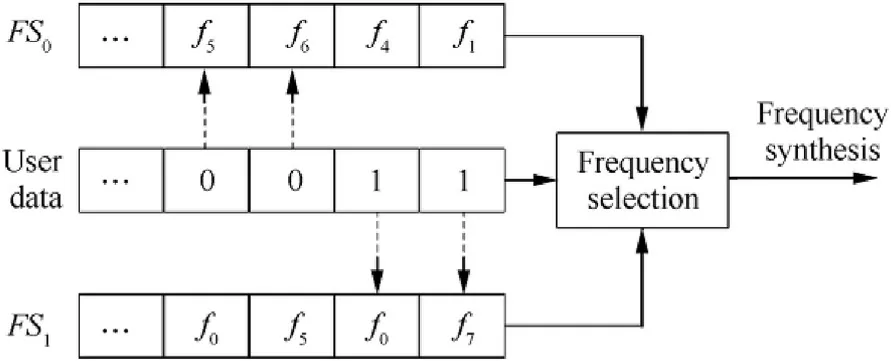
Fig.1. Frequency selection schematic diagram of WGMPFH.
As shown in Fig.2,the current user data is 0,and the frequency synthesizer outputs a carrier with frequencyf(0,t).Assuming thatdenotes the energy per symbol andTSdenotes the symbol duration, the equivalent expression of the signal transmitted by WGMPFH is


When the signal is transmitted in AWGN channel, the received signal can be expressed as Wheren(t) is additive Gaussian white noise, for which the unilateral power spectral density(PSD)isN0.nJ(t)is the jamming signal,and θ is the phase difference generated in the transmission process.We define the equivalent signal-to-noise ratio (SNR) is γ=ES/N0.
As shown in Fig.2,the receiving end uses the FH patternFS0′andFS1′synchronized with the FH patternsFS0andFS1of the transmitting end, and the synchronization method adopts the selfsynchronization method. The received signal is entered into two receiving channels.FS0′andFS1′respectively control the frequency synthesizer of each receiving channel to generate FH demodulation signal. After mixing, the received signal is moved to intermediate frequency (IF) for further processing.
After narrow-band IF filtering, incoherent energy detection is carried out for the two channels. We assume the energy detection results of receiving channel representing “0” isr0. And the energy detection results of receiving channel representing “1” isr1. The detected decision quantityr1can be expressed as

Whereis conjugate of sending signalsi(t), equivalent demodulation process. The expression ofsi(t) is the same ass(t)when user data is taken asi.

In this paper, WGMPFH restore the user data by hard-decision.Whenr0>r1is determined, the user data currently sent is 0,otherwise, the user data is 1.
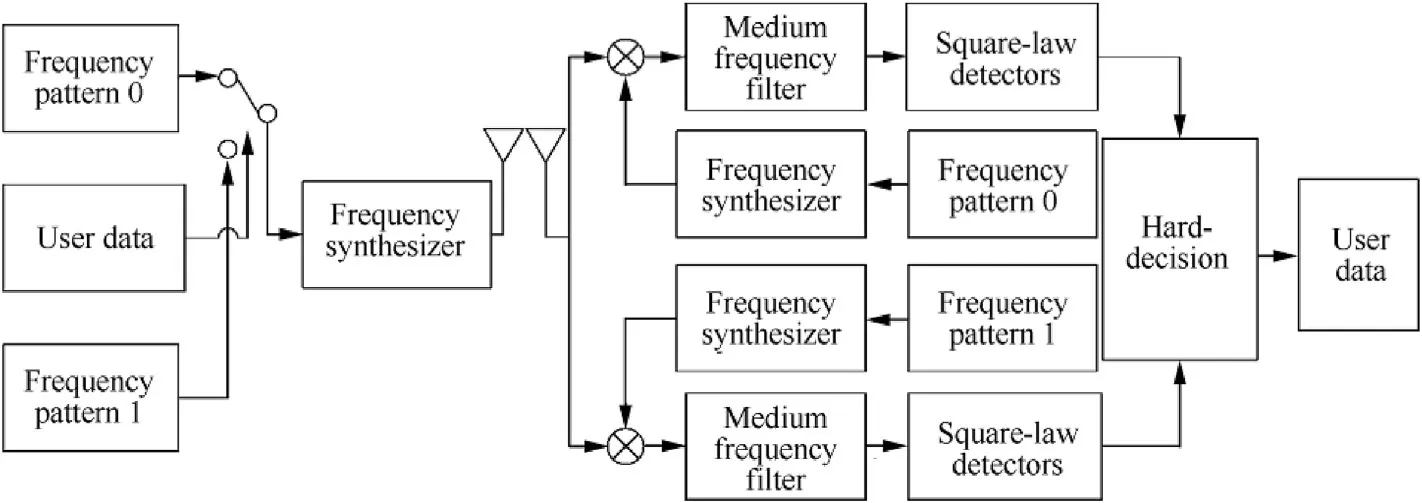
Fig. 2. Block diagrams of the WGMPFH.
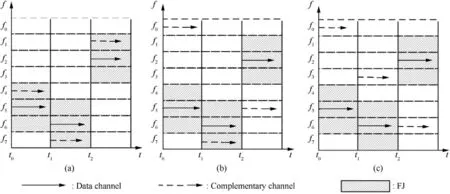
Fig. 3. FJ's impact on different systems: (a) FH/BFSK; (b) MPFH; (c) WGMPFH.
As shown in Fig.3,FJ covers the transmitted signal with a certain bandwidth.Without loss of generality,we assume that FJ performs well and always successfully tracks the transmitted signal. For FH/BFSK, FJ always covers both the data channel and the complementary channel, which has a great influence on the receiver decision. For MPFH, FJ is lured by the transmitted signal in the data channel, while the complementary channel hops randomly according to another FH pattern. FJ covers both data channel and complementary channel with a certain probability. WGMPFH adopts the wide gap multi-patterns,which guarantees a minimum interval between the data channel and the complementary channel. When FJ is narrow, the complementary channel will not be covered by FJ,and when FJ is wide,the complementary channel will be covered by FJ with a low probability. For the above three systems, when jamming exists in the data channel and the complementary channel, both channels will have large energy, so it is difficult for the receiver to distinguish between two channels.When only the data channel is being jammed, the energy in the data channel is enhanced.No transmitted signal or jamming signal exists in the complementary channel, so the energy in the complementary channel is small, and the receiver can easily select the data channel, and the error probability is low in this case. For WGMPFH, data channel and complementary channel have the lowest probability to be jammed at the same time among these systems,therefore,the anti-follower jamming ability is strong.
2.2. The construction of wide gap multi-patterns
The FH patterns from a general FH sequences family can satisfy the characteristics such as orthogonality and randomness.If two FH patterns are taken from a general FH sequences family,a wide gap between these two patterns cannot be guaranteed. If two FH sequences families occupy different FH bands and each FH pattern is selected from different FH sequences families,the pseudo-random property will be affected.Because in this case,some frequency slots always represent 0, and some frequency slots always represent 1.Therefore, a pseudo-random variable and two FH sequences families are introduced.
The frequency slots occupied by FH sequences families is constantly changing. The pseudo-random variable controls where the frequency slots is occupied by sequences families and the position of the interval bands.The FH pattern determines the relative position of the corresponding frequency slot of each hop in the frequency slots occupied by the sequences family. In this way, the original characteristics of patterns in the sequences family can be guaranteed,and the wide gap characteristics between the patterns selected in each sequences family can be guaranteed.
In the FH bandwidth,WSS, we assume thatf0f1…fN-1corresponds toNfrequency slots in the order of frequency from small to large. As shown in Fig. 4,Nfrequency slots are divided into four bands, which contain two signal bands and two interval bands.Each signal band corresponds to a FH sequences family, which occupiesLfrequency slots. And each interval band occupiesGfrequency slots,where no signal exists.ThereforeL,GandNsatisfy the following relationship
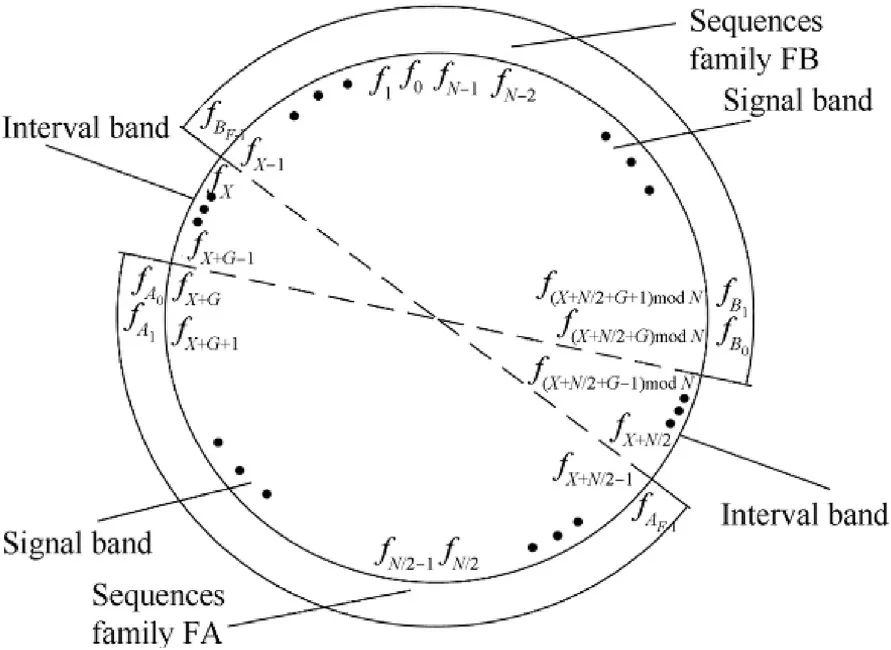
Fig. 4. Schematic diagram of the relationship among sequences family FA, sequences family FB, pseudo-random variable X, signal bands, interval bands and real frequency slots.

X(X=0,1, …,N/2-1) is a pseudo-random variable, determined by a pseudo-random sequence, which determines the position of interval bands.As shown in Fig.4,fXtofX+G-1andfX+N/2tofX+N/2+G-1constitute two interval bands and the other frequency slots constitute two signal bands.Without loss of generality,we assume the data channel selects a frequency slot from signal bandA, and the complementary channel selects a frequency slot from another signal bandB. Every signal band containsLfrequency slots. We constructed two FH sequences families FA and FB,each containingLFH sequences. FA containsLorthogonal frequency slotsfAi(i=0,1,…,L-1)and FB containsLorthogonal frequency slotsfBj(i=0,1,…,L-1).irepresents the relative position inLorthogonal frequency slots in FH sequences family FA, andjrepresents the relative position inLorthogonal frequency slots in FH sequences family FB.The position of the signal bands varies with the position of the interval bands.Therefore,the relative position(i,j)in a signal band and the real position(AiandBj) in total FH bandwidth satisfy the following relationship

We select a FH sequence from FH sequences family FA and go through transformation (6) as FH patternFS0, and select a FH sequence from FH sequences family FB and go through transformation (7) as FH patternFS1. For example, we assumeN=12,G=2 andL=4. Every FH sequences family contains 4 FH sequences.We select a FH sequencefA1fA3fA0fA2from the sequences family FA and a FH sequencefB2fB0fB1fB3from the sequences family FB. As shown in Fig. 5, interval bands hopping withfXand the frequency slots occupied by signal bands changing with interval bands. In Fig. 5,fXjumps in order off2f5f0f3. After the above transformation,FH sequencefA1fA3fA0fA2become FH patternFS0,f5f10f2f7,and FH sequencefB2fB0fB1fB3become FH patternFS1,f0f1f9f2. If the user data are “1010”, the frequency synthesizer in turn synthesizes the carrier frequency off0f10f9f7.
3. Anti-jamming performance analysis
Without loss of generality, we assume that the user data is a sequence of all zeros,that is,sub-channel 0 is the data channel and sub-channel 1 is the complementary channel.The BER of WGMPFH depends on the jamming state of the data channel and the complementary channel.We denote jamming state indicatorqi=1 or 0,whereqi=1 represents the frequency slot of channeliis jammed in this hop,andqi=0 represents the frequency slot of channeliis not jammed.Moreover,we denote the random variableGj=(q0,q1)to represent the jamming state of WGMPFH.Pe(a,b)is the conditional BER whenq0=aandq1=b. In addition,pi|qirepresents the probability density function (PDF) of the decision variable riwhen the frequency slot of channeliis in stateqiin a hop. The relationship amongq0,q1,Gjand corresponding condition BER is shown in Table 1.
Therefore, the BER of WGMPFH can be expressed as

Where the conditional BER of WGMPFH can be expressed as

In this paper,we consider follower noise jamming[24],which is modeled as narrowband noise over bandwidthWJwith equivalent one-sided PSDNJ.In order to measure the FJ energy,we denote the equivalent SJR as γJ=ES/NJ.As shown in Fig.3,the FJ signal follows the transmitted signal with a certain bandwidth. In most cases, it takes a short time for FJ to track the transmitted signal at each hop.And the effective jamming time is the time from the time the transmitted signal is tracked by FJ to the transmitted signal hop to the next frequency slot.The jamming energy that delays to the next hop is negligible. We define jamming duration ratio ρT=TJ/Th,tracking success probability β and jamming bandwidth ratio ρW=WJ/WSSthat determine the effect of FJ. WhereThis the hop duration andTJis the jamming duration in a hop.For the detector of sub-channeli, the total PSD of jamming and noise is

Table 1 The relationship among q0, q1,Gj and corresponding condition BER in a hop.
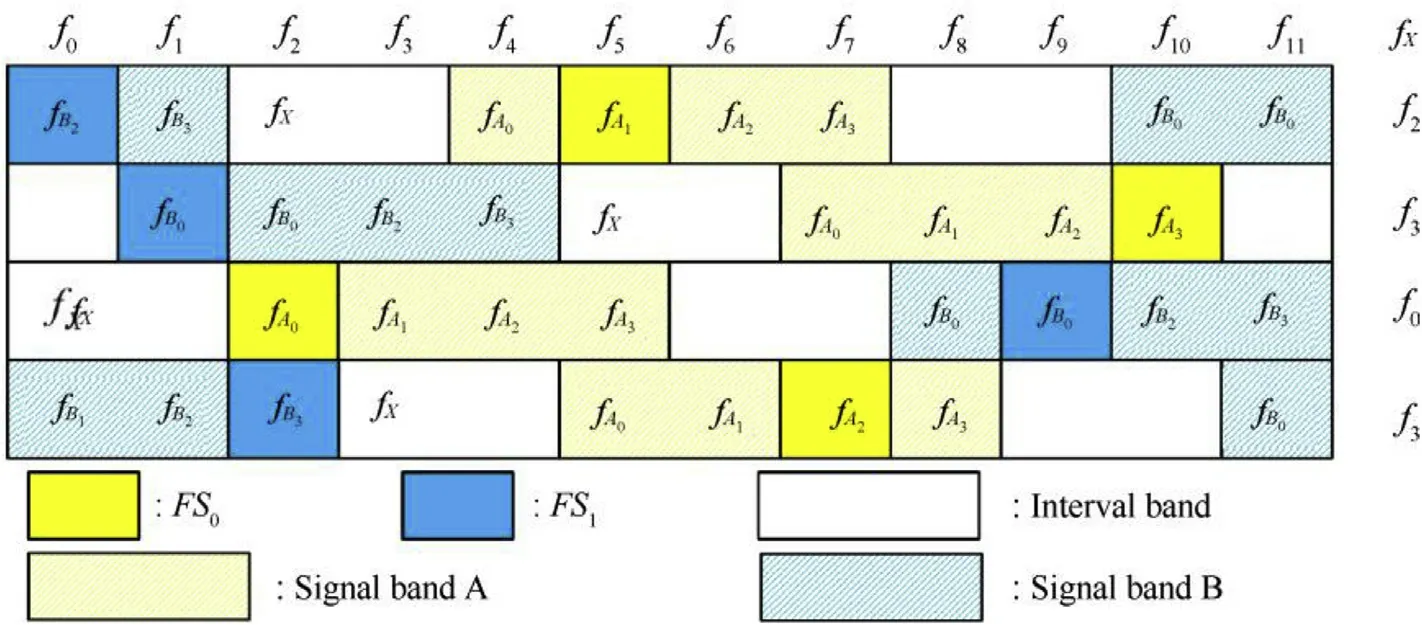
Fig. 5. Schematic diagram of the relationship between FH sequences in sequences families and wide gap multi-patterns.

Therefore, the PDF of decision variableriunder jamming conditionqican be expressed as

WhereI0(x) is the 0th-order modified Bessel function of the first kind,U(x)is the unit step function.Substituting(12)-(13)into(9),we get the conditional BER under jamming stateq0andq1is

In WGMPFH, β is the probability of the data channel being jammed by FJ in a hop,and the probability of the data channel not being jammed is 1- β. The complementary channel is jammed when it randomly collides with the FJ.
There areNfrequency slots in the total FH bandwidth and the FJ can cover ρWNfrequency slots. We assume the data channel is jammed,when the interval band between the data channel and the complementary channel is larger than(ρWN-1)/2 frequency slots,the complementary channel can't be jammed by the FJ. When the interval band between the data channel and the complementary channel is smaller than (ρWN- 1)/2 frequency slots, there are still ρWN-2G-1 frequency slots in the FJ that could be collided with by the complementary channel. Therefore the probability thatGjhappens in the case of FJ is as follow
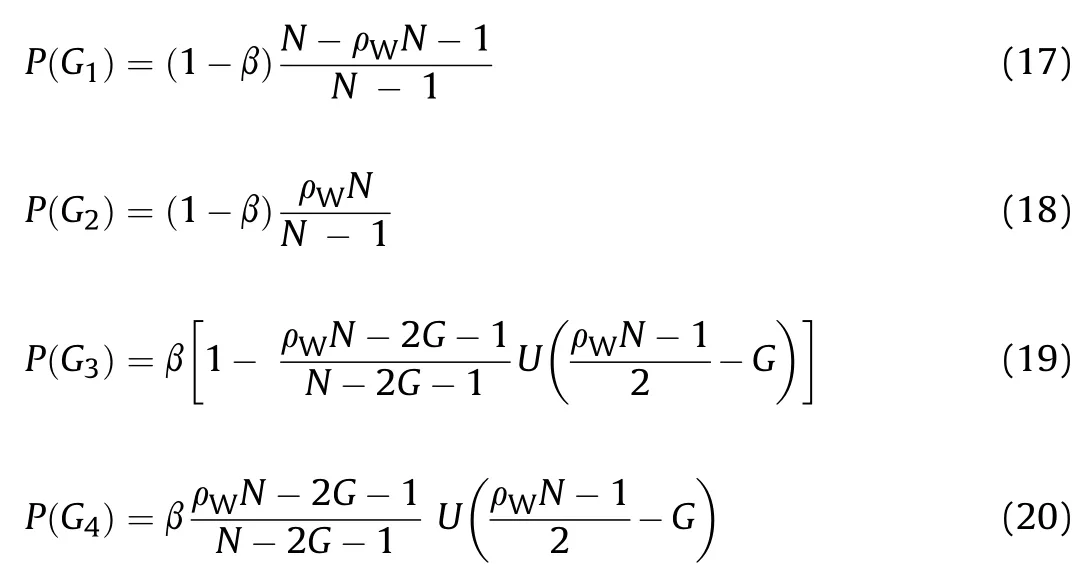
Substituting(13)-(16)and(17)-(20)into(8),we can get the BER of WGMPFH under FJ in AWGN channel.
4. Simulation results and discussions
In this section, numerical and simulation BER results of the proposed WGMPFH under FJ are presented. We analyze the FJ rejection performances of the proposed WGMPFH and compare them with conventional FH/BFSK and MPFH. Without the loss of generality, we examine the WGMPFH and MPFH withN=64 and the channel spacing is 25 kHz. In FH/BFSK, the frequency slot representing 0 and the frequency slot representing 1 are adjacent,that is,the interval between them is 25 kHz.The resultant bandwidth of a nonoverlapping frequency slot for FH/BFSK is 50 kHz, which equals the bandwidth of the data channel plus the bandwidth of the complementary channel for WGMPFH. We set the SNR to be 13.35 dB,which corresponds to the BER of 10-5for the WGMPFH in AWGN channel under no jamming conditions.Without considering channel coding,we adopt symbol-by-symbol detection decoding.
Fig. 6 provides comparisons between the analytical results and simulation results on BER versus SJR for the proposed WGMPFH.The WGMPFH operates withGfrequency slots as minimum gap and the FJ operates with jamming bandwidth ratio ρW=5/64,jamming duration ratio ρT=1 and tracking success probability β =1. Fig. 6 shows that the BER of WGMPFH decreases with the increase ofG.But whenGexceeds a certain value, the BER no longer decreases.This is because when the interval band is less than the bandwidth of FJ, the larger the interval band, the lower the probability of the complementary channel colliding with the FJ. When the interval band is greater than the bandwidth of FJ, the complementary channel will no longer be jammed by the FJ. Therefore, increasing the interval band will not further reduce the BER. Moreover, the close match between the analytical results and simulation results justifies the accuracy of the approximation in the derivation.
The effect of jamming bandwidth ratio ρWon the BER of WGMPFH versus FH/BFSK is shown in Fig.7(a).When ρWdecreases,the BER of FH/BFSK increases due to the energy of the FJ signal being more concentrated on the transmission signal. However, in WGMPFH, the relationship between ρWand BER is different. In severe SJR, BER of WGMPFH drops as ρWdecreases. Above the medium SJR,BER of WGMPFH drops as ρWincreases.This is because the FJ in the data channel will enhance the received energy in the data channel, which helps the receiver distinguish between the data channel and the complementary channel. As shown in Fig. 7(b), MPFH has similar characteristics with WGMPFH. As SJR and ρWdecrease,FJ will provide more energy for the data channel.This gain will become weaker with the increase of SJR and ρW.And the smaller the ρW, the lower the probability that the complementary channel collides with the FJ.It is shown in Fig.7(b)that WGMPFH performs better than MPFH especially in severe SJR.Because wide gap patterns set the minimum interval between the data channel and the complementary channel, which makes the complementary channel of WGMPFH have a lower probability of being hit by FJ than MPFH. It can be observed that the WGMPFH outperforms FH/BFSK by more than 4 dB and outperforms MPFH by more than 0.5 dB. The FJ rejection performance gain of WGMPFH gets even greater when SJR goes severe.
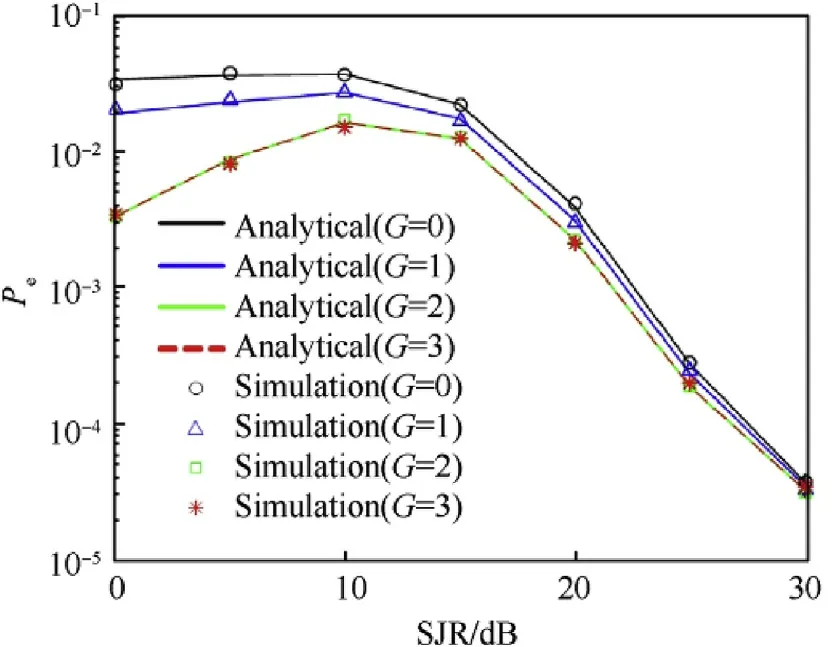
Fig. 6. Comparisons of analytical and simulation BER results of WGMPFH with different G under FJ with ρW=5/64, ρT=1, β =1 and SNR=13.35 dB.
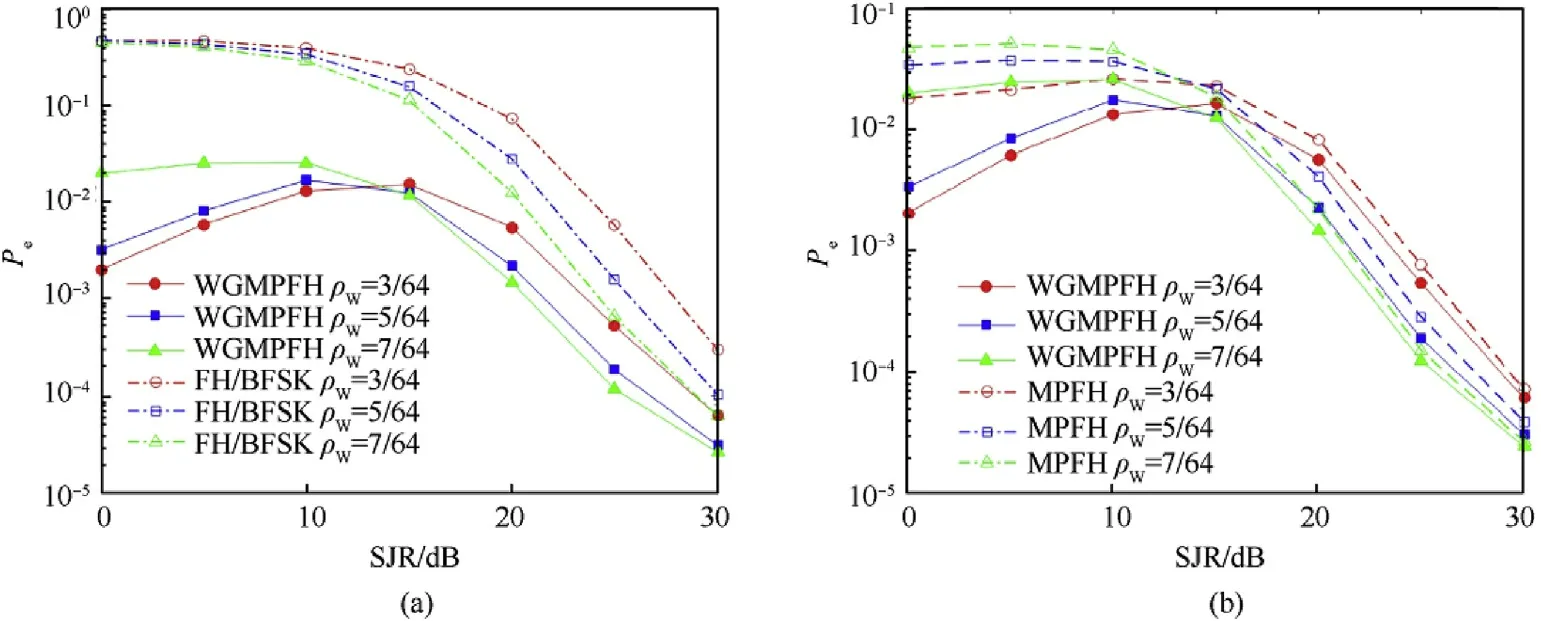
Fig. 7. Effect of jamming bandwidth ratio (ρW) on BER Performance of WGMPFH under FJ with β =1 and ρT=1: (a) Compared with FH/BFSK; (b) Compared with MPFH.
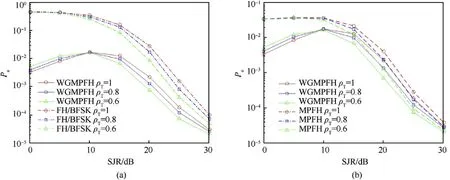
Fig. 8. Effect of jamming duration ratio (ρT) on BER Performance of WGMPFH under FJ with ρW=5/64 and β =1: (a) Compared with FH/BFSK; (b) Compared with MPFH.
Fig.8(a)and Fig.8(b)show the effect of jamming duration ratio ρTon the BER performance of WGMPFH versus FH/BFSK and MPFH under FJ. Significantly, the BER of WGMPFH is lower than that of both of the conventional FH/BFSK and MPFH. To achieve the same BER, the WGMPFH generally requires a SJR about 4 dB lower than the FH/BFSK and 1 dB lower than the MPFH with equal ρT. The FJ rejection performance gain of WGMPFH gets even greater when SJR goes severe.Moreover,in severe SJR,the BER of WGMPFH drops as ρTdecreases.We know the larger the ρTis,the greater the jamming energy is.In FH/BFSK,once the data channel is successfully tracked by FJ, the adjacent complementary channel will be jammed simultaneously too. The increase of jamming energy will make it more difficult for the receiver to distinguish between the data channel and the complementary channel.MPFH separates the data channel and the complementary channel pseudorandomly by using different FH patterns and WGMPFH uses wide gap multi-patterns to keep the complementary channel away from the data channel.The jamming energy in the data channel makes the difference between the energy of the data channel and the complementary channel more obvious, and it is easier for the receiver to make a correct decision. The larger the FJ energy, the more significant the enhancement effect in WGMPFH. Therefore, the larger ρTis, the more obvious this anti-jamming gain of WGMPFH is, especially in severe SJR.

Fig. 9. Effect of tracking success probability (β) on BER Performance of WGMPFH under FJ with ρW=5/64 and ρT=1: (a) Compared with FH/BFSK; (b) Compared with MPFH.
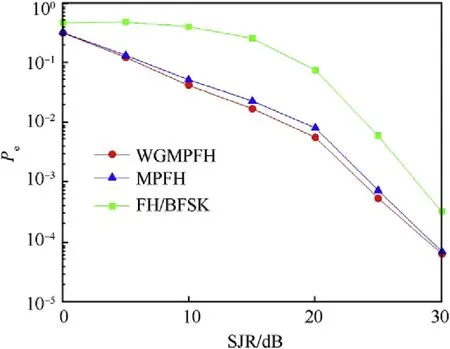
Fig.10. WGMPFH, MPFH and FH/BFSK BER performance under the worst-case FJ with SNR=13.35 dB.
Similar phenomenon occurs when we research the effect of tracking success probability β on the BER performance of WGMPFH versus FH/BFSK and MPFH under FJ. In Fig. 9(a) and Fig. 9(b), the BER of WGMPFH is lower than that of both of the conventional FH/BFSK and MPFH.To achieve the same BER,the WGMPFH generally requires SJR about 4 dB lower than the FH/BFSK and 1 dB lower than the MPFH with equal β. The FJ rejection performance gain of WGMPFH gets even greater when the SJR becomes severe.And for severe SJR,BER of WGMPFH drops as β decreases.It is obvious that the higher the β is, the higher is the probability of FJ tracking the data channel,the higher is the probability of the receiver making a correct decision,especially in severe SJR.Therefore,the larger β is,the more obvious is this anti-jamming gain of WGMPFH,especially in severe SJR.
The worst-case FJ is defined as when ρWis chosen to maximize the BER for the same SJR. In Fig.10, it can be observed that when suffering the worst-case FJ,the WGMPFH outperforms FH/BFSK by more than 4 dB. The performance of WGMPFH is about 1-3 dB higher than that of MPFH under moderate SJR(10-20 dB).
5. Conclusions
In this paper,we proposed the anti-jamming WGMPFH method to improve the performance of MPFH under FJ. In WGMPFH, FJ is lured to the data channel,increasing the energy in the data channel.Wide gap multi-patterns is adopted to keep the complementary channel far away from FJ and reduce the probability of the complementary channel being affected by FJ. Therefore, the energy of the FJ signal is concentrated in the data channel, which helps the receiver to correctly determine the data channel. Furthermore,wide gap multi-patterns are constructed by using the existing sequences family to ensure many characteristics of the FH pattern,such as the orthogonality. And a pseudo-random variable is introduced to control the position of the frequency band occupied by the sequences family to ensure the pseudo-randomness of the FH pattern. The only cost is reduced the utilization of the spectrum across the system.We derived the BER of the WGMPFH and studied the effects of jamming parameters on the system in detail. It is shown that the proposed WGMPFH has a superior FJ rejection capability compared with the conventional FH/BFSK and MPFH,especially for severe SJR.
Foundation items
The National Natural Science Foundation of China(No.61531009,No.61471108).
The National Major Projects of China (No.2016ZX03001009).
杂志排行
Defence Technology的其它文章
- Defence Technology
- An air cavity method for increasing the underwater acoustic targets strength of corner reflector
- Enhancing the explosive characteristics of a Semtex explosive by involving admixtures of BCHMX and HMX
- Modeling and realization of real time electronic countermeasure simulation system based on SystemVue
- Numerical investigation of dynamic interaction with projectile and harmonic behaviour for T-finned machine gun barrels
- The prediction formula and a risk-based sensor scheduling method in target detection with guiding information
